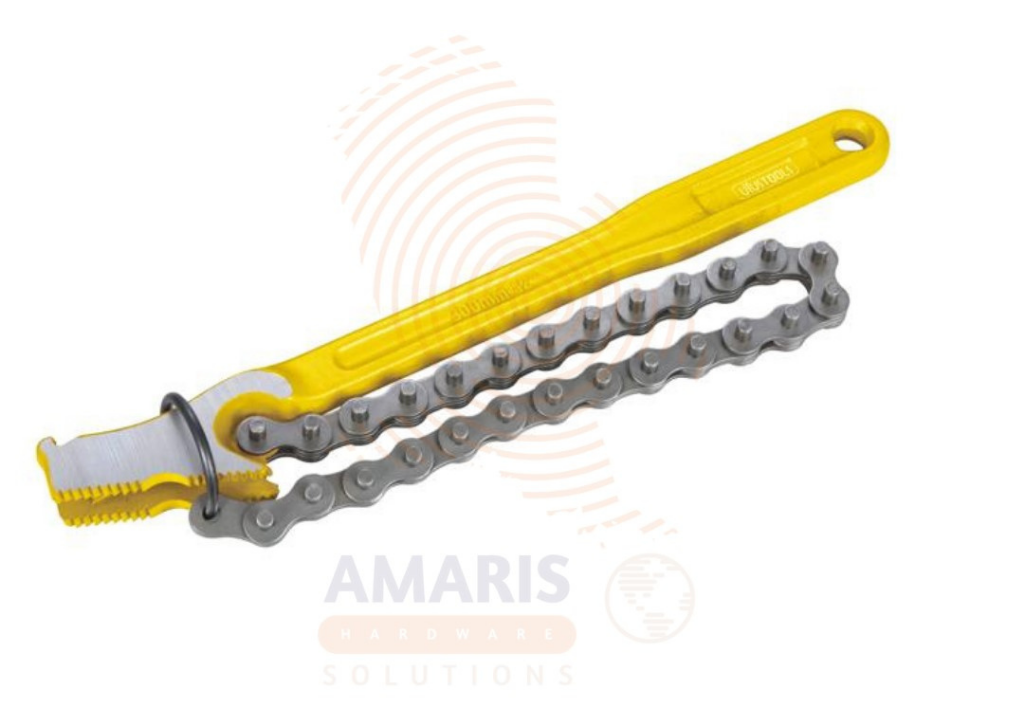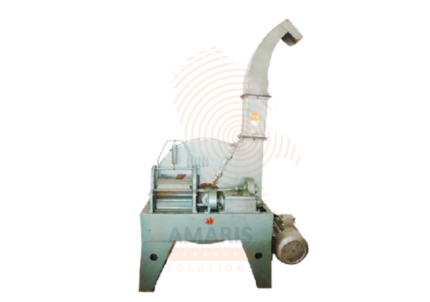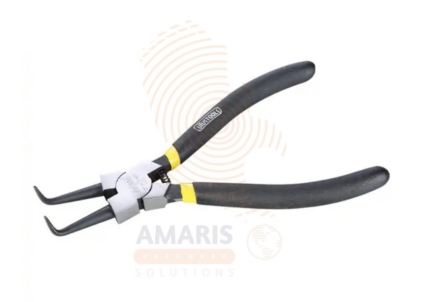Chain Pipe Wrench
WhatsApp Order
A chain pipe wrench is a type of adjustable wrench designed for gripping and turning pipes or cylindrical objects with a round surface. It consists of a handle with an attached chain and a set of interlocking jaws. The chain is looped around the pipe, and as the handle is turned, the jaws tighten around the pipe, providing a secure grip. This design allows the chain pipe wrench to handle pipes of varying sizes and provides a strong, non-slip grip for turning or loosening pipes and fittings.
Description
Table of Contents
ToggleChain Pipe Wrench
Uses
-
Pipe Installation and Removal:
-
Tightening and loosening pipes and fittings during installation or removal.
-
Providing a strong grip on pipes with smooth surfaces for threading or unthreading.
-
-
Plumbing Repairs:
-
Repairing or replacing sections of pipes by securely gripping and turning them.
-
Loosening stubborn or rusted pipe connections.
-
-
Oil and Gas Industry:
-
Used for maintenance and repair of pipes and fittings in the oil and gas industry.
-
Handling pipes in various sizes and materials commonly found in this industry.
-
-
Construction Work:
-
Assisting in the assembly or disassembly of scaffolding where pipes are used as structural elements.
-
Turning and securing pipes in construction applications.
-
-
Mechanical Work:
-
Assisting in maintenance and repairs of machinery where pipes and fittings are involved.
-
Tightening or loosening nuts and bolts on pipe flanges.
-
-
Water and Sewer Systems:
-
Working on water and sewer lines, tightening or loosening connections.
-
Repairing or replacing sections of pipes in municipal plumbing systems.
-
-
Industrial Maintenance:
-
Use in various industrial settings for maintenance tasks involving pipes.
-
Handling different pipe sizes and materials commonly found in industrial environments.
-
-
HVAC (Heating, Ventilation, and Air Conditioning) Systems:
-
Assisting in the installation and maintenance of pipes and fittings in HVAC systems.
-
Turning pipes during the assembly or disassembly of heating and cooling components.
-
-
Shipbuilding and Maritime Applications:
-
Use in shipyards for the installation and maintenance of pipes on ships.
-
Handling pipes and fittings in maritime applications.
-
-
General Plumbing Tasks:
-
Everyday plumbing tasks, such as installing or replacing sink pipes, showerheads, or other plumbing fixtures.
-
Working on household water supply or drainage systems.
-
SAFETY HANDLING PRECAUTIONS
Safety Precautions
-
Wear Personal Protective Equipment (PPE):
-
Always wear appropriate PPE, including safety glasses or goggles to protect your eyes from debris or splashing liquids.
-
Consider wearing work gloves to protect your hands from sharp edges or hot surfaces.
-
-
Inspect the Tool:
-
Before use, inspect the chain pipe wrench for any damage, such as cracks, bent parts, or worn jaws.
-
Ensure that the chain is in good condition without any signs of wear or weakness.
-
-
Choose the Right Size:
-
Select a chain pipe wrench that is appropriate for the size of the pipe or fitting you are working on.
-
Using the correct size ensures a secure grip and reduces the risk of slippage.
-
-
Position Yourself Properly:
-
Stand in a stable and balanced position while using the chain pipe wrench.
-
Keep your feet shoulder-width apart to maintain balance and stability.
-
-
Secure the Workpiece:
-
Make sure the pipe or fitting is securely supported and won't move unexpectedly during wrenching.
-
Avoid working on slippery or unstable surfaces.
-
-
Apply Even Pressure:
-
Use controlled and even pressure when turning the handle of the chain pipe wrench.
-
Avoid excessive force, as it may lead to loss of control or damage to the tool.
-
-
Avoid Overextension:
-
Do not overextend your reach or use extensions on the wrench handle.
-
Maintain a comfortable and ergonomic working posture to prevent strain or injury.
-
-
Use Two Wrenches for Added Stability:
-
In situations where additional stability is needed, use two chain pipe wrenches, one to hold and stabilize the workpiece and the other to turn.
-
-
Beware of Pinch Points:
-
Be cautious of pinch points on the wrench, especially when the chain is being tightened.
-
Keep hands and fingers away from moving parts.
-
-
Work in Well-Lit Areas:
-
Ensure proper lighting in your work area to enhance visibility and reduce the risk of accidents.
-
-
Know the Pipe Material:
-
Be aware of the material of the pipe you are working on, especially in industrial settings where hazardous materials may be present.
-
-
Follow Manufacturer's Guidelines:
-
Adhere to the manufacturer's instructions and guidelines for the specific chain pipe wrench you are using.
-
Related products
Bodywork Tool Set
A Bodywork Tool Set typically refers to a collection of seven specialized tools designed for use in automotive body repair and restoration. These tools are specifically crafted to assist in shaping, smoothing, and repairing the body panels of vehicles, addressing issues such as dents, dings, and other imperfections. The set may include various tools such as hammers, dollies, and other shaping implements, each serving a specific purpose in the process of restoring or enhancing the appearance of a vehicle's bodywork. These tool sets are commonly used by auto body technicians, mechanics, or individuals involved in automotive restoration projects.
Countersink Drill Set
A countersink drill set typically refers to a collection of six tools designed for countersinking operations in woodworking or metalworking. Each set usually includes six individual countersink drills with varying sizes or angles. Countersinking is a process that involves creating a conical hole in a material, allowing the head of a screw or bolt to sit flush with or below the surface. These drill sets are essential for achieving a professional finish in various applications where a smooth and even surface is desired, such as in carpentry, metal fabrication, or DIY projects.
Double – End Bits Set
PRODUCT DESCRIPTION
A Double-End Bits Set typically refers to a collection of interchangeable tool bits designed for use with screwdrivers, power drills, or similar tools. Each bit in the set has two distinct ends with different types or sizes of tips, allowing the user to perform various tasks without needing multiple individual bits. These sets often include a variety of common bit types, such as Phillips, slotted, Torx, or hex, providing versatility for different screw and fastener types. The double-ended design allows users to flip the bit and switch between different tips easily, making it a convenient and space-saving solution for various applications.
Electrician Screwdriver Set
An electrician screwdriver set typically refers to a collection of six individual screwdrivers specifically designed for use by electricians. These screwdriver sets often include a variety of sizes and types of screwdrivers that are commonly used in electrical work. The set may include Phillips and slotted screwdrivers in different sizes, as well as insulated handles to provide electrical safety when working on live circuits. The goal of such a set is to provide electricians with a versatile and comprehensive tool kit to tackle various tasks in the field of electrical work.
Electronic Wire Stripper
PRODUCT DESCRIPTION
An electronic wire stripper is a specialized handheld tool designed for efficiently and accurately removing the insulation or outer covering from electrical wires. It incorporates motorized or automated mechanisms to cut through and strip the insulation without damaging the underlying conductive wire. This tool is commonly used in electrical and electronic applications to streamline the process of preparing wires for connection, ensuring precision and reducing the risk of damage to the wire during the stripping process.
External Circlip Pliers Bent
External circlip pliers – bent refer to a specialized hand tool designed for the installation and removal of external circlips. A circlip, also known as a retaining ring or snap ring, is a type of fastener or retaining device that fits into a groove on a cylindrical object, such as a shaft or a bore. External circlips are positioned on the outside of the shaft or bore.
The term "bent" in the context of external circlip pliers describes the shape of the tool. These pliers typically have angled or bent tips that allow for easier access to the external circlip, especially in tight or confined spaces. The bent design helps the user reach and manipulate the circlip more effectively, providing improved maneuverability during installation or removal.
Fiberglass Open Reel Long Tape Rule
PRODUCT DESCRIPTION
A Fiberglass Open Reel Long Tape is a measuring tool designed for accurately determining distances in various applications, such as construction, surveying, and landscaping. It typically consists of a durable, flexible fiberglass tape housed on an open reel. The fiberglass material provides strength and resistance to stretching, ensuring precise measurements over extended lengths. The open reel design allows for easy deployment and retraction of the tape, facilitating efficient use in outdoor and large-scale measurement scenarios. These tapes often feature clear and legible markings, making them suitable for both personal and professional use in situations where accurate and reliable distance measurements are essential.
Flat Wood File
PRODUCT DESCRIPTION
A flat wood file is a hand tool used for shaping, smoothing, and refining the surfaces of wood. It typically consists of a flat, narrow, rectangular piece of metal with a series of parallel, coarse teeth or ridges along one or both of its sides. These teeth are designed to efficiently remove material when drawn across the wood grain, allowing for the leveling and smoothing of wooden surfaces. Flat wood files are commonly used in woodworking and carpentry for tasks such as shaping edges, refining contours, and removing rough spots on wood surfaces.


 Acrylic Sealants
Acrylic Sealants Construction Adhesives
Construction Adhesives Double-Sided Tape
Double-Sided Tape Duct Tape
Duct Tape Electrical Tape
Electrical Tape Epoxy & Resins
Epoxy & Resins Masking Tape
Masking Tape
 Automotive Wrenches & Socket Sets
Automotive Wrenches & Socket Sets Battery Chargers & Jump Starters
Battery Chargers & Jump Starters Car Jacks & Stands
Car Jacks & Stands Car Wash & Detailing Products
Car Wash & Detailing Products Diagnostic Tools
Diagnostic Tools Tire Inflators
Tire Inflators Vehicle Lighting
Vehicle Lighting Oil & Lubricants
Oil & Lubricants
 Adhesives & Sealants
Adhesives & Sealants Bricks & Blocks
Bricks & Blocks Cement & Concrete
Cement & Concrete Drywall & Plaster
Drywall & Plaster Flooring (Tiles, Wood, Laminate)
Flooring (Tiles, Wood, Laminate) Lumber & Plywood
Lumber & Plywood Paints, Primers & Coatings
Paints, Primers & Coatings Insulation Materials
Insulation Materials Roofing Materials
Roofing Materials
 Circuit Breakers
Circuit Breakers Electrical Cables & Wires
Electrical Cables & Wires Switches & Sockets
Switches & Sockets Fuses & Relays
Fuses & Relays Connectors & Terminals
Connectors & Terminals Electrical Boxes & Panels
Electrical Boxes & Panels Conduit & Fittings
Conduit & Fittings Lighting Fixtures & Bulbs
Lighting Fixtures & Bulbs Extension Cords & Power Strips
Extension Cords & Power Strips
 Anchors
Anchors Bolts
Bolts Clips & Clamps
Clips & Clamps Screws
Screws Nuts
Nuts Washers
Washers Rivets
Rivets Nails
Nails Threaded Rods
Threaded Rods
 Hammers
Hammers Measuring Tools (Tapes, Levels, Calipers)
Measuring Tools (Tapes, Levels, Calipers) Screwdrivers
Screwdrivers Pliers & Cutters
Pliers & Cutters Saws & Blades
Saws & Blades Chisels & Punches
Chisels & Punches Allen Keys & Hex Keys
Allen Keys & Hex Keys Ratchets & Socket Sets
Ratchets & Socket Sets Wrenches & Spanners
Wrenches & Spanners
 Power Tool Accessories (Blades, Bits, Discs)
Power Tool Accessories (Blades, Bits, Discs) Rotary Tools
Rotary Tools Saws (Circular, Jigsaw, Reciprocating)
Saws (Circular, Jigsaw, Reciprocating) Drills & Drivers
Drills & Drivers Grinders & Sanders
Grinders & Sanders Heat Guns
Heat Guns Nail Guns
Nail Guns Impact Wrenches
Impact Wrenches Batteries & Chargers
Batteries & Chargers
 Pipes & Fittings (PVC, Copper, PEX)
Pipes & Fittings (PVC, Copper, PEX) Plumbing Tools
Plumbing Tools Pumps & Motors
Pumps & Motors Sealants & Adhesives for Plumbing
Sealants & Adhesives for Plumbing Valves & Taps
Valves & Taps Water Heaters
Water Heaters Drainage Systems
Drainage Systems Faucets & Fixtures
Faucets & Fixtures Hoses & Tubing
Hoses & Tubing
 Hinges & Latches
Hinges & Latches Hooks & Brackets
Hooks & Brackets Window Hardware
Window Hardware Chains & Cables
Chains & Cables Casters & Wheels
Casters & Wheels Shelving & Storage Systems
Shelving & Storage Systems Door Handles & Locks
Door Handles & Locks Drawer Slides & Cabinet Hardware
Drawer Slides & Cabinet Hardware
 Personal Protective Equipment (PPE)
Personal Protective Equipment (PPE) Respirators & Masks
Respirators & Masks Safety Glasses
Safety Glasses Safes
Safes Security Cameras
Security Cameras Gloves
Gloves Helmets
Helmets Ear Protection
Ear Protection Fire Safety Equipment
Fire Safety Equipment Locks & Padlocks
Locks & Padlocks Motion Sensors & Alarms
Motion Sensors & Alarms
 Garden Fencing
Garden Fencing Garden Furniture Hardware
Garden Furniture Hardware Lawn Mowers
Lawn Mowers Trimmers & Edgers
Trimmers & Edgers Shovels & Spades
Shovels & Spades Rakes & Hoes
Rakes & Hoes Pruning Shears & Loppers
Pruning Shears & Loppers Watering Systems (Hoses, Sprinklers, Nozzles)
Watering Systems (Hoses, Sprinklers, Nozzles)
 Interior Paints
Interior Paints Paint Brushes & Rollers
Paint Brushes & Rollers Paint Strippers & Thinners
Paint Strippers & Thinners Paint Trays & Accessories
Paint Trays & Accessories Exterior Paints
Exterior Paints Spray Paints
Spray Paints Primers & Undercoats
Primers & Undercoats Varnishes & Stains
Varnishes & Stains
 Gaskets & Seals
Gaskets & Seals Hydraulic Fittings
Hydraulic Fittings Industrial Fasteners
Industrial Fasteners Industrial Hoses
Industrial Hoses Lubricants & Greases
Lubricants & Greases Metal Sheets & Bars
Metal Sheets & Bars Bearings & Bushings
Bearings & Bushings Belts & Pulleys
Belts & Pulleys
 HVAC Filters
HVAC Filters Insulation for HVAC
Insulation for HVAC Air Conditioners
Air Conditioners Refrigerants
Refrigerants Ventilation Ducts & Fittings
Ventilation Ducts & Fittings Thermostats & Controllers
Thermostats & Controllers Fans & Blowers
Fans & Blowers
 Pegboards & Hooks
Pegboards & Hooks Shelving Units
Shelving Units Storage Bins & Containers
Storage Bins & Containers Toolboxes & Tool Chests
Toolboxes & Tool Chests Workbenches
Workbenches Drawer Organizers
Drawer Organizers Labeling Supplies
Labeling Supplies
 Welding Accessories (Clamps, Brushes)
Welding Accessories (Clamps, Brushes) Welding Electrodes & Rods
Welding Electrodes & Rods Welding Helmets & Gloves
Welding Helmets & Gloves Welding Machines
Welding Machines Soldering Irons & Stations
Soldering Irons & Stations Flux & Solder Wire
Flux & Solder Wire
 Generator Accessories
Generator Accessories Inverters
Inverters Portable Generators
Portable Generators Power Inverters
Power Inverters Transfer Switches
Transfer Switches Diesel & Gasoline Generators
Diesel & Gasoline Generators
 Transport Equipment: Carts, Dollies, and Hand Trucks
Transport Equipment: Carts, Dollies, and Hand Trucks Storage Solutions: Pallets, Racks, and Containers
Storage Solutions: Pallets, Racks, and Containers Lifting Equipment: Hoists, Cranes, and Jacks
Lifting Equipment: Hoists, Cranes, and Jacks Conveyors and Accessories: Belts and Rollers
Conveyors and Accessories: Belts and Rollers







